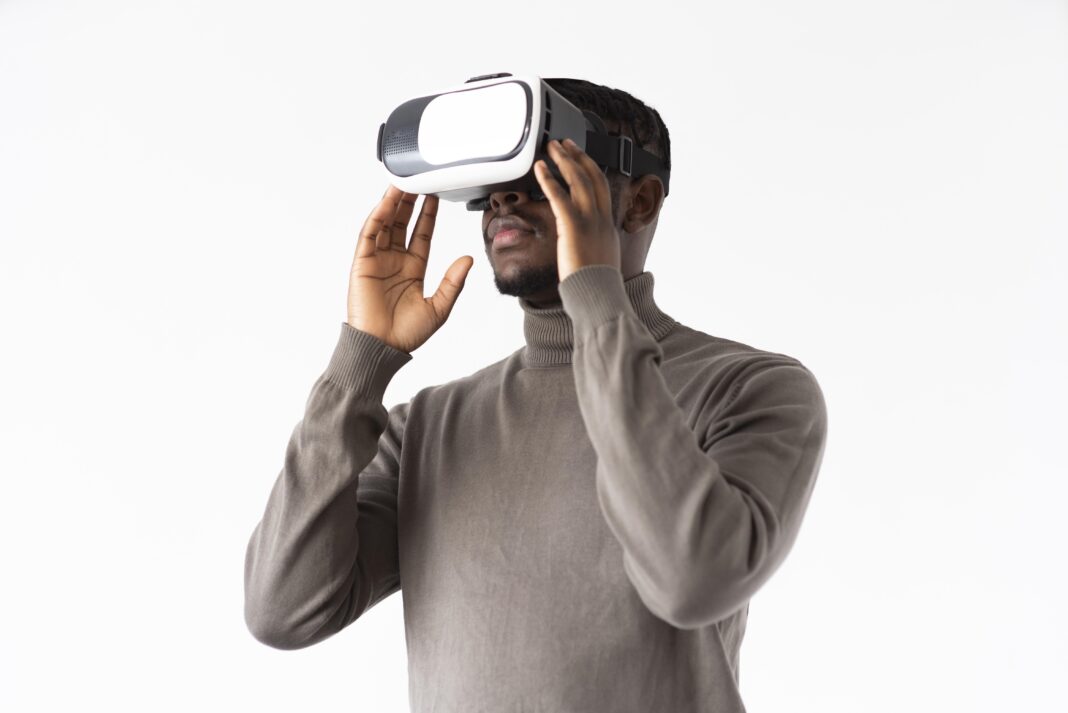Augmented Reality (AR) has fundamentally changed the way we interact with mobile applications. By seamlessly blending digital elements into the real world, AR enhances user experiences, making them more engaging, practical, and immersive. This technology is no longer confined to niche applications—it is now a driving force in industries ranging from retail and gaming to healthcare and education.

This in-depth guide examines how AR works in apps, its most impactful use cases, the challenges developers face, and what the future holds for this transformative technology.
Understanding Augmented Reality in Mobile Apps
What Is Augmented Reality?
Augmented Reality (AR) superimposes digital content—such as 3D models, text, animations, or interactive elements—onto the physical world through a device’s camera. Unlike Virtual Reality (VR), which immerses users in a fully digital environment, AR enhances real-world surroundings with additional layers of information.
Core Technologies Behind AR Apps
Several advanced technologies enable AR to function smoothly in mobile applications:
- Computer Vision
- Allows devices to recognize objects, surfaces, and environments.
- Essential for accurately placing virtual objects in real-world spaces.
- Simultaneous Localization and Mapping (SLAM)
- Tracks the device’s position in real-time while mapping the surroundings.
- Ensures virtual objects stay anchored in place as the user moves.
- Depth Sensing (LiDAR & Infrared)
- Measures distances between objects for better AR placement.
- Used in newer iPhones and iPads for high-precision AR experiences.
- Artificial Intelligence (AI) & Machine Learning
- Enhances object recognition (e.g., detecting faces for AR filters).
- Enables real-time interactions within AR environments.
- AR Development Frameworks
- ARKit (Apple) and ARCore (Google) provide tools for developers to build AR apps efficiently.
- Platforms like Unity and Unreal Engine support advanced 3D AR experiences.
How AR Differs from VR and Mixed Reality (MR)
- AR enhances the real world with digital overlays (e.g., Pokémon GO).
- VR creates a fully immersive digital environment (e.g., Oculus Rift).
- MR blends real and virtual worlds, allowing interaction with both (e.g., Microsoft HoloLens).
Key Industries Leveraging AR in Mobile Apps
1. Retail & E-Commerce
AR is revolutionizing online shopping by allowing customers to visualize products before purchasing.
Examples of AR in Retail Apps:
- IKEA Place – Lets users place virtual furniture in their homes to check fit and style.
- Sephora Virtual Artist – Allows makeup try-ons using facial recognition.
- Amazon AR View – Enables users to see how products look in their space.
Impact:
- Reduces return rates by improving purchase confidence.
- Enhances customer engagement through interactive shopping.
2. Gaming & Entertainment
AR gaming apps merge digital gameplay with real-world environments, creating immersive experiences.
Popular AR Games & Apps:
- Pokémon GO – Players catch virtual creatures in real-world locations.
- Harry Potter: Wizards Unite – Combines AR with location-based gameplay.
- Snapchat & Instagram Filters – Use face-tracking AR for fun, interactive effects.
Impact:
- Boosts user retention through real-world exploration.
- Encourages social sharing, increasing app virality.
3. Healthcare & Medical Training
AR is improving diagnostics, surgical planning, and medical education.
Leading AR Healthcare Apps:
- AccuVein – Projects vein maps onto a patient’s skin for easier injections.
- Proximie – Allows surgeons to guide procedures remotely using AR overlays.
- Complete Anatomy – Provides 3D interactive models for medical students.
Impact:
- Enhances precision in surgeries and medical procedures.
- Reduces training costs by simulating real-life scenarios.
4. Education & Training
AR makes learning interactive by bringing abstract concepts to life.
Top AR Education Apps:
- Google Expeditions – Takes students on virtual field trips using AR.
- Anatomy 4D – Lets users explore detailed 3D human anatomy models.
- JigSpace – Offers step-by-step AR explanations of complex machinery.
Impact:
- Improves knowledge retention through visual and interactive learning.
- Makes education more accessible and engaging.
5. Navigation & Real Estate
AR enhances navigation apps and property viewing experiences.
Innovative AR Navigation & Real Estate Apps:
- Google Maps Live View – Overlays directions onto real-world streets for easier walking navigation.
- Zillow 3D Home Tours – Lets buyers explore properties virtually before visiting.
- Measure Apps (iOS/Android) – Use AR to measure real-world objects accurately.
Impact:
- Simplifies urban navigation with real-time AR guidance.
- Saves time in real estate by enabling virtual property tours.
Challenges in AR App Development
Despite its rapid growth, AR still faces several hurdles:
1. Hardware Limitations
- Not all smartphones support advanced AR features.
- High-performance AR requires powerful processors and sensors.
2. Battery Consumption
- AR apps drain battery life quickly due to constant camera and sensor usage.
3. Privacy & Security Concerns
- Camera-based AR apps raise data privacy issues (e.g., facial recognition).
- Ensuring secure AR data transmission is critical.
4. User Adoption Barriers
- Some users still see AR as a gimmick rather than a practical tool.
- Requires educating consumers on AR’s real-world benefits.
5. Development Costs
- High-quality AR experiences demand significant investment in 3D modeling and AI.
Solutions:
- Optimizing AR apps for lower-end devices.
- Implementing efficient battery management techniques.
- Ensuring transparent data privacy policies.
The Future of AR in Mobile Apps
1. Wider Adoption of AR Glasses
- Companies like Apple (Apple Glass) and Meta are developing AR wearables.
- Smart glasses could replace smartphones for hands-free AR interactions.
2. 5G & Cloud-Based AR
- Faster internet speeds will enable real-time cloud-rendered AR experiences.
- Reduces device dependency for high-quality AR.
3. AI-Powered Personalization
- AR apps will use AI to deliver customized experiences based on user behavior.
4. AR in Remote Work & Collaboration
- Virtual meeting spaces with 3D avatars and interactive whiteboards.
- AR-assisted remote repairs and training.
5. Expansion in Automotive & Smart Cities
- AR dashboards displaying navigation and hazard alerts.
- AR-guided maintenance for smart infrastructure.
Frequently Asked Questions (FAQs)
Q1: What devices support AR apps?
Most modern smartphones with ARKit (iOS) or ARCore (Android) compatibility can run AR apps. High-end devices with LiDAR sensors (e.g., iPhone Pro models) offer better AR performance.
Q2: Is AR only used in gaming?
No, AR is widely used in retail, healthcare, education, navigation, and more.
Q3: How does AR improve online shopping?
AR allows customers to visualize products (e.g., furniture, makeup, clothes) in real-world settings before buying, reducing returns.
Q4: Will AR replace traditional apps?
AR won’t replace standard apps but will increasingly integrate with them for richer experiences.
Q5: What’s the biggest challenge for AR adoption?
Hardware limitations and battery drain are key obstacles, but advancements in 5G and wearable tech will help overcome them.
Final Thoughts
Augmented Reality is no longer a futuristic concept—it’s a present-day reality reshaping mobile applications across industries. From enhancing shopping experiences to revolutionizing medical training, AR’s potential is vast.
As technology evolves, AR will become more seamless, accessible, and integral to everyday apps. Businesses and developers who embrace AR now will lead the next wave of digital innovation.

